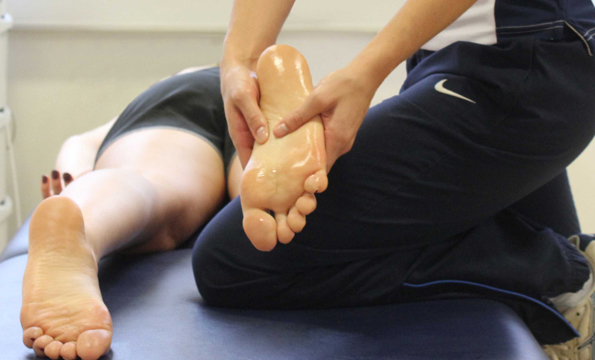What is a calcaneal spur?
A calcaneal spur is a small bony projection that is formed on the calcaneus or heel bone. It is caused by putting too much pressure on the sinew on the soles of the feet.What causes heel pain and calcaneal spurs?
Every time you take a step, one of your heels has to support the whole weight of your body. The load is softened by a pillow of fat under the heel and a large sinew which is a bridge like support of the arch of the foot that is attached to the heel bone (calcaneum) behind and toe bone in front (metatarsal). Unused exercise might overload the muscles of the calf or the Achilles tendon. These are also fixed on the heel bone. The overload can cause inflammation and even small cracks in the sinew. To compensate for the repeated damage to the sinew, the body will try and repair it in the same way that it would attempt to repair a broken bone, namely, by wrapping it up in boney tissue. The result is a small bony projection on the heel bone where this sinew is attached called a calcaneal spur. But it is not the spur itself that causes the pain. The spur is the result of a prolonged overload of the sinew at the sole of the foot.What are the symptoms of calcaneal spur?
A sharp, stabbing pain under or on the inside of the heel, which typically is relieved during rest, but is worse after getting up again. It is most painful first thing in the morning. Most sufferers are weekend athletes and those who are overweight and middle-aged. This is due to shrinking of the shock-absorbing fat pillow under the foot with aging.How to prevent the problem?
Take time to warm up and stretch before taking part in sport or exercise and cool down afterwards. If you run or jog, it is better to run a short distance several times a week than one long run once a week. Manage your weight, regularize your sleep and eating habits. Change your bad habits of smoking, alcohol etc.,How to manage the heel pain?
To help the healing process, follow the RICE principle, which stands for Rest, Ice, Compression and Elevation. Rest the foot and do not run until it is completely healed. To provide deep rest do DRT several times in the day after every activity. In designing the set asana practices, alternate the standing asanas with sitting, prone or supine postures based on the principle of stretch followed by rest. This improves blood flow and hastens the healing process. Ice Pack: alternate cold and heat will help in hastening healing. Compression and elevation: sit in Vajrasana followed by Viparitha karani or sarvangasana at least three times in the day. Whenever you need to sit down at home sit in vajrasana. This asana gives the pressure on the vajra nadi which is the acupressure point to correct the prana imbalance. On very painful days an elastic support bandage to foot and elevate the foot with support on the chair or pillow. A short built obese middle aged lady came to me with these complaints of heel pain which had bothered her for two years. This had recurred even after several types of therapies. After she was cured through yoga therapy she took a promise from me that through yoga i will tell all my future clients that “Vajrasana cures heel pain of Calcaneal spur”.KATHAKALI POSTURE
- Stand in Tadasana, heels together, toes a little apart, hands by the side of body.
- While inhaling, lift the arms upwards from side; give a distance between toes, making an angle of about 180 degree.
- While exhaling, bend the knees, sit on the heels. Here the knees should be as apart as possible.
- Perform a chin mudra and place it on respective knees. Maintain this posture. Keeping head, neck back in one single straight line looking straight forward with normal breathing.
Disclaimer
Yoga Ayurveda Therapy is Complementary Medicine and doesn't alternates any conventional treatment.
Yoga-Ayurveda Therapy needs physical assistance which may need physical touch. You can ask teacher or therapist not to give physical touch or assistance and based on whatever you choose, our teacher or therapist will follow the instructions. Any point you want to change the preference, then please inform teacher or therapist and management in writing. You will take responsibility of your decision and will not hold Union Yoga Ayurveda responsible for any kind of damage.
All kind of Yoga Ayurveda teaching and therapy can cause certain injuries and you are accepting those injuries. Signing up for the therapy or yoga courses means that you are aware of the probable injuries.
Union Yoga Ayurveda (Union Centre Pte Ltd) and its staff are not liable or responsible for any injuries caused during the session which are visible or not visible, physical or hormonal or mental. You as client take full responsibility of your own decision and will not claim any kind of compensation in terms of money or any resources for the damage caused because of due process.
Prev Post
High Blood Pressure and Yoga Therapy
Next Post

